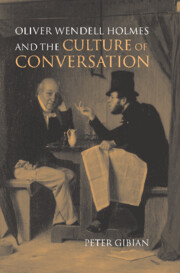Book contents
- Frontmatter
- Contents
- Acknowledgments
- Introduction
- PART ONE OPENING THE CONVERSATION
- PART TWO HOLMES IN THE CONVERSATION OF HIS CULTURE
- 2 “TO CHANGE THE ORDER OF CONVERSATION”: interruption and vocal diversity in Holmes' American talk
- 3 “COLLISIONS OF DISCOURSE” I: THE ELECTRODYNAMICS OF CONVERSATION A carnival of verbal fireworks
- 4 “COLLISIONS OF DISCOURSE” II: ELECTRIC AND OCEANIC “CURRENTS” IN CONVERSATION The cultural work of Holmesian talk
- 5 A CONVERSATIONAL APPROACH TO TRUTH: the Doctor in dialogue with contemporary truth-sayers
- 6 CONVERSATION AND “THERAPEUTIC NIHILISM”: the Doctor in dialogue with contemporary medicine
- 7 THE SELF IN CONVERSATION: the Doctor in dialogue with contemporary psychology
- PART THREE THE TWO POLES OF CONVERSATION
- PART FOUR CLOSING THE CONVERSATION
- Notes
- Index
3 - “COLLISIONS OF DISCOURSE” I: THE ELECTRODYNAMICS OF CONVERSATION A carnival of verbal fireworks
Published online by Cambridge University Press: 22 September 2009
- Frontmatter
- Contents
- Acknowledgments
- Introduction
- PART ONE OPENING THE CONVERSATION
- PART TWO HOLMES IN THE CONVERSATION OF HIS CULTURE
- 2 “TO CHANGE THE ORDER OF CONVERSATION”: interruption and vocal diversity in Holmes' American talk
- 3 “COLLISIONS OF DISCOURSE” I: THE ELECTRODYNAMICS OF CONVERSATION A carnival of verbal fireworks
- 4 “COLLISIONS OF DISCOURSE” II: ELECTRIC AND OCEANIC “CURRENTS” IN CONVERSATION The cultural work of Holmesian talk
- 5 A CONVERSATIONAL APPROACH TO TRUTH: the Doctor in dialogue with contemporary truth-sayers
- 6 CONVERSATION AND “THERAPEUTIC NIHILISM”: the Doctor in dialogue with contemporary medicine
- 7 THE SELF IN CONVERSATION: the Doctor in dialogue with contemporary psychology
- PART THREE THE TWO POLES OF CONVERSATION
- PART FOUR CLOSING THE CONVERSATION
- Notes
- Index
Summary
We must not begin by talking of pure ideas – vagabond thoughts that tramp on the public roads without any human habitation – but must begin with men and their conversation.
C. S. PeirceIn Victorian America the “separate sphere” of the Castle-Home was never as insular, fortified, static, or coherent as its occupants might have wished. Holmes' written conversations help us to regain a sense of the dynamism of mid-century domestic life as they bring out all that is at stake in table-talk and table manners, showing how even the most mundane moments of verbal intercourse in the parlor, the dining room, or the club can become charged encounters, sparked by ongoing alternations between polarized voices struggling for power: assertion continually meets counter-assertion, dominance meets resistance. Through his structured reenactments of parlor talk, Holmes points out that the champagne-pops of repartee within genteel salon walls can have far-reaching repercussions; the matchbox explosions that divide debaters at his boardinghouse can be seen as warning shots predicting the much larger explosions soon to erupt across the entire “House Divided” of America.
“THIS CARNIVAL-SHOWER OF QUESTIONS AND REPLIES AND COMMENTS”
Almost every reader of Holmes' works, in every era, thinks of some form of fireworks when trying to describe the “explosive” literary effects of his witty extended metaphors and juxtapositions and his unusually interruptive table-talk form.
Information
- Type
- Chapter
- Information
- Oliver Wendell Holmes and the Culture of Conversation , pp. 91 - 109Publisher: Cambridge University PressPrint publication year: 2001
